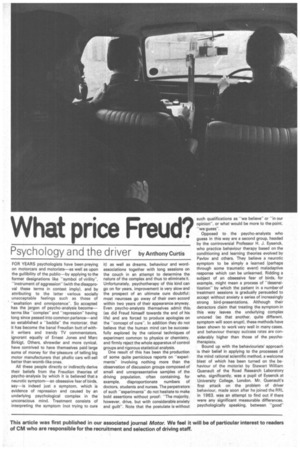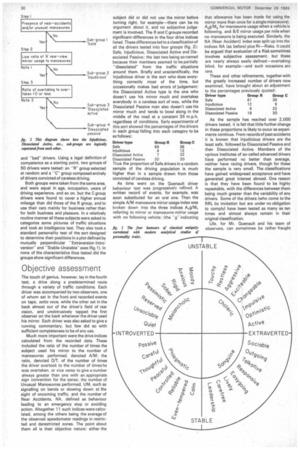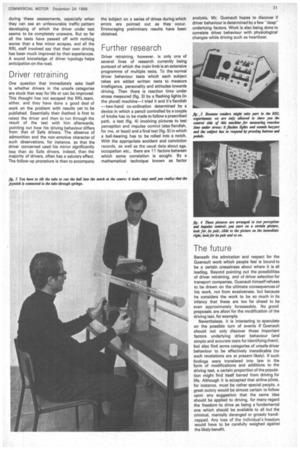What price Freud.
Page 31

Page 32

Page 33

If you've noticed an error in this article please click here to report it so we can fix it.
Psychology and the driver by Anthony Curtis FOR YEARS psychologists have been preying on motorcars and motorists—as well as upon the gullibility of the public—by applying to the former designations like "symbol of virility", "instrument of aggression" (with the disapproval these terms in context imply), and by attributing to the latter various socially unacceptable feelings such as those of "exaltation and omnipotence". So accepted has the jargon of psycho-analysis become— terms like "complex" and "repressionhaving long since passed into common parlance—and so established a -baddie" the motorcar, that it has become the banal Freudian butt of withit writers and trendy TV commentators, ignorant equally of Ernest Jones and Marc Birkigt. Others, shrewder and more cynical. have contrived to have themselves paid large sums of money for the pleasure of telling big motor manufacturers that phallic cars will sell better than womb-like ones,
All these people directly or indirectly derive their beliefs from the Freudian theories of psycho-analysis by which it is believed that a neurotic symptom—an obsessive fear of birds, say--is indeed just a symptom, which is evidence of repression and caused by art underlying psychological complex in the unconscious mind. Treatment consists of interpreting the symptom Mot trying to cure
it) as well as dreams, behaviour and wordassociations together with long sessions on the couch in an attempt to determine the nature of the complex and thus to eliminate it. Unfortunately, psychotherapy of this kind can go on for years, improvement is very slow and the prospect of an ultimate cure doubtful; roost neuroses go away of their own accord within two years of their appearance anyway. Even psycho-analysts themselves admit this. as did Freud himself towards the end of his life) and are forced to produce apologies on the -concept of cure". In addition they do not believe that the human mind can be successfully explored by the rational techniques of experiment common to physics or chemistry. and firmly reject the whole apparatus of control groups and rigorous statistical analysis.
One result of this has been the production of some quite pernicious reports on "experiments" involving nothing more than the observation of discussion groups composed of small and unrepresentative samples of the driving population, often containing, for example, disproportionate numbers of doctors students and nurses. The perpetrators of such "experiments" do not hesitate to make bold assertions without proof: "The majority, however, drive, but with considerable anxiety and guilt". Note that the postulate is without such qualifications as "we believe" or "in our opinion", or what would be more to the point, "we guess".
Opposed to the psycho-analysts who guess in this way are a second group, headed by the controversial Professor H. J. Eysenck, who practice behaviour therapy based on the conditioning and learning theories evolved by Pavlov and others. They believe a neurotic symptom to be simply a learned (perhaps through some traumatic event) maladaptive response which can be unlearned. Ridding a subject of an obsessive fear of birds, for example, might mean a process of -desensitization" by which the patient in a number of treatment sessions is gradually persuaded to accept without anxiety a series of increasingly strong bird-presentations. Although their detractors claim that treating the symptom in this way leaves the underlying complex uncured (so that another, quite different, symptom will soon erupt), these methods have been shown to work very well in many cases, and behaviour therapy success rates are considerably higher than those of the psychotherapists.
Bound up with the behaviourists' approach is their belief in applying to the processes of the mind rational scientific method, a welcome blast of which has been turned on the behaviour of the motorist by Stewart William Quenault of the Road Research Laboratory who, significantly, was a pupil of Eysenck at University College, London, Mr. Quenaulfs first attack on the problem of driver behaviour, made soon after he joined the RRL in 1963. was an attempt to find out if there were any significant measurable differences, psychologically speaking, between "good"
and "bad" drivers. Using a legal definition of competence as a starting point, two groups of 50 drivers were tested: an -R" group selected at random and a "C" group composed entirely of drivers convicted of careless driving.
Both groups were taken from the same area, and were equal in age, occupation, years of driving experience, and so on, but the C group drivers were found to cover a higher annual mileage than did those of the R group, and to use their cars mainly for business rather than for both business and pleasure. In a relatively routine manner all these subjects were asked to categorize some pictures of traffic situations and took an intelligence test. They also took a standard personality test of the sort designed to determine their positions in a plot defined by mutually perpendicular "Extraversion-Introversion" and "Stable-Unstable" axes (fig. 1). In none of the characteristics thus tested did the groups show significant differences.
Objective assessment
The touch of genius. however, lay in the fourth test, a drive along a predetermined route through a variety of traffic conditions. Each driver was accompanied by two observers, one of whom sat in the front and recorded events on tape. sotto voce, while the other sat in the back almost out of the driver's field of rear vision, and unobtrusively tapped the first observer on the back whenever the driver used his mirror. Each driver was also asked to give a running commentary, but few did so with sufficient completeness to be of any use.
Much more important were the drive indices calculated from the recorded data. These included the ratio of the number of times the subject used his mirror to the number of manoeuvres performed, denoted AA/I: the ratio, denoted 0/1, of the number of times the driver overtook to the number of times he was overtaken, or vice versa to give a number always greater than one with an appropriate sign convention for the sense: the number of Unusual Manoeuvres performed, UM, such as signalling on bends or slowing down at the sight of oncoming traffic, and the number of Near Accidents, NA, defined as behaviour leading to an emergency stop or avoiding action. Altogether 11 such indices were calculated, among the others being the average of the observed speedometer readings in restricted and derestricted zones. The point about them all is their objective nature: either the subject did or did not use the mirror before turning right, for example—there can be no argument about it. and no subjective judgement is involved. The R and C groups recorded significant.differences in the four drive indices listed. These differences led to a classification of all the drivers tested into four groups (fig. 2): Safe, Injudicious, Dissociated Active and Dissociated Passive; the last two being so named because their members seemed to be partially "dissociated" from the traffic situations around them. Briefly and unscientifically, the Injudicious driver is the sort who does everything correctly roost of the time, but occasionally makes bad errors of judgement the Dissociated Active type is the one who doesn't use his mirror much and overtakes everybody in a careless sort of way, while the Dissociated Passive man also doesn't use his mirror much and tends to bowl along in the middle of the road at a constant 35 m.p.h, regardless of conditions. Early experiments of this sort showed the percentages of the drivers in each group falling into each category to be as follows: Injudicious 4 12 Dissociated Active 7 32 Dissociated Passive 20 20 Thus the proportion of Safe drivers in a random sample of the driving population is much higher than in a sample drawn from those convicted of careless driving.
As time went on the Quenault driver behaviour test was progressively refined. A written record of events, for example, was soon substituted for an oral one. Then the simple A/IVI manoeuvre mirror usage index was broken down into the three indices Aig/MI referring to mirror or manoeuvre-mirror usage with no following vehicle: (the "g" indicating fig. I The four humours of classical antiquit,v correlated with modern analytical studies of personality traits. that allowance has been Made for using the mirror more than once for a single manoeuvre), A2g/M2 for manoeuvre usage when a vehicle is following, and B/E mirror usage per mile when no manoeuvre is being executed. Similarly, the NA (Near Accident) index was split up into the indices NA (as before) plus Ri—Risks. It could be argued that evaluation of a Risk sometimes involves subjective assessment, but these are nearly always easily defined—overtaking blind, for example—and such occasions are rare.
These and other refinements, together with the greatly increased number of drivers now examined, have brought about an adjustment to the percentages previously quoted: Driver type Group R Group C Safe 61 39 Injudicious 12 9 Dissociated Active 9 22 Dissociated Passive 18 30 As the sample has reached over 2,000 drivers tested, it is felt that little further change in these proportions is likely to occur as experiments continue. From records of past accidents it is known that Injudicious drivers are the least safe, followed by Dissociated Passive and then Dissociated Active. Members of the various institutes of so-called advanced drivers have performed no better than average, neither have racing drivers, though for these the sample is very small. The classifications have gained widespread acceptance and have generated great interest abroad. One reason is that they have been found to be highly repeatable, with the differences between thorn being much greater than the variability of any drivers. Some of the drivers (who come to the RRL by invitation but are under no obligation to comply) have been tested as many as ten times and almost always remain in their original classification.
Life, for Mr. Quenault and his team of observers, can sometimes be rather fraught during these assessments, especially when they can see an unfavourable traffic pattern developing of which the driver under test seems to be completely unaware. But so far all the tests have passed off with nothing worse than a few minor scrapes, and all the RRL staff involved say that their own driving has been much improved by their experiences. A sound knowledge of driver typology helps anticipation on the road.
Driver retraining
One question that immediately asks itself is whether drivers M the unsafe categories are stuck that way for life or can be improved. This thought has not escaped the RRL team, either, and they have done a good deal of work on the problem with results yet to be published. Essentially their Method is first to retest the driver and then to run through the result of the test with him afterwards, pointing out how his driving behaviour differs from that of Safe drivers. The absence of admonition and the non-emotive character of such observations, for instance, as that the driver concerned used his mirror significantly less than do Safe drivers, indeed, than the majority of drivers, often has a salutary effect. The follow-up procedure is then to accompany the subject on a series of drives during which errors are pointed out as they occur. Encouraging preliminary results have been obtained.
Further research
Driver retraining, however, is only one of several lines of research currently being pursued of which the main limb is an extensive programme of multiple tests. To the normal driver behaviour tests which each subject takes are added written tests to measure intelligence. personality and attitudes towards driving. Then there is reaction time under stress measured (fig. 3) by a flashing lights (in the plural) machine—'-1 tried it and it's fiendish —two-hand co-ordination determined by a device in which a pencil controlled by a couple of knobs has to be made to follow a prescribed path, a test (fig. 4) involving pictures to test perception and impulse control (also fiendish, for me, at least) and a final test (fig. 5) in which a ball-bearing has to be rolled into a notch. With the appropriate accident and conviction records, as well as the usual data about age, occupation etc., there are 11 factors between which some correlation is sought. By a mathematical technique known as factor
The future
Beneath the admiration and respect for the Quenault work which people feel is bound to be a certain uneasiness about where it is all leading. Beyond pointing out the possibilities of driver retraining, and of driver selection for transport companies, Quenault himself refuses to be drawn on the ultimate consequences of his work, not from evasiveness, but because he considers the work to be so much in its infancy that these are too far ahead to be even approximately foreseeable. No grand proposals are afoot for the modification of the driving test, for example.
Nevertheless, it is interesting to speculate on the possible turn of events if Quenault should not only discover those important factors underlying driver behaviour (and simple and accurate tests for identifying them), but also find some categories of unsafe driver behaviour to be effectively ineradicable (no such revelations are at present likely). If such findings were translated into law in the form of modifications and additions to the driving test, a certain proportion of the population might find itself barred from driving for life. Although it is accepted that airline pilots, for instance, must be rather special people, a great outcry would be almost certain to follow upon any suggestion that the same idea should be applied to driving, for many regard the freedom to drive as being a fundamental one which should be available to all but the criminal, mentally deranged or grossly handicapped. Any loss of the individual's freedom would have to be carefully weighed against the likely benefit.












































































